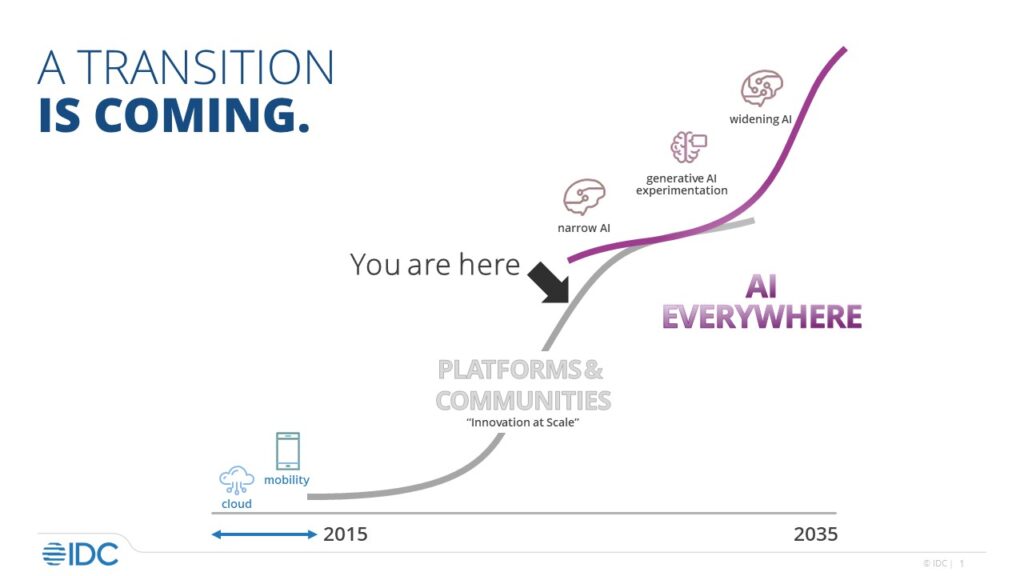The tech industry is at a seminal moment. The combination of executive and board level interest, clearly defined outcomes, and the sheer speed of adoption makes Generative AI unlike anything we have seen before.
In this blog, we will shed light on the rapid rise of Generative AI (GenAI), its impact on tech companies, and fundamental questions related to AI technology.
The rapid adoption of Generative AI moves AI from an emerging software segment in the stack to a lynch-pin technology at the center of a platform transition.
Meredith Whalen – Chief Research Officer
GenAI – A Seminal Moment in Technology
In seven short months, GenAI has simultaneously captured the attention, imagination, and trepidation of tech and business leaders across the world.
- Attention. Executives easily see how this technology will impact productivity levels and margins. The Brookings Institution forecasts GenAI will raise productivity and output by 18% over the next 10 years.
- Imagination. GenAI has a wide range of applications – from horizontal use cases such as software development and marketing content creation to industry-specific use cases such as drug discovery and manufacturing design. The business benefits of the use cases are obvious, and enterprises aren’t waiting around for a business case to be developed to start experimenting. IDC’s research shows that knowledge management, marketing, and code generation are the top use cases being considered.
- Trepidation. Executives see how this technology can rapidly disrupt their business model. The 20-year journey for the cloud to represent 50% of core IT spending and the 10-year journey to become a digital business will look colossally slow in comparison to the accelerated timeframes it will take for enterprises to implement Generative AI use cases at scale. The well-founded concerns around ethics, regulatory compliance, and governance will also need to be embedded in this new business model.
Hiding in Plain Sight

How did technology with this much impact creep up on most business leaders? It didn’t. The foundational elements were being developed throughout the past decade.
- Era of Multiplied Innovation. What IDC refers to as the Era of Multiplied Innovation was primarily fueled by the cloud, mobility, and the Internet. Low-cost semiconductors and virtualization enabled the cloud, which made computing elastic and plentiful. Mobility made computing ubiquitous. And the internet dropped the costs of distributing those computing bits to almost zero.
- Platforms and Communities. With abundant, ubiquitous, and elastic infrastructure in place, platforms, communities, and digital ecosystems emerged. These platforms triggered a massive data consolidation process and the birth of the transformer model architecture which enabled the creation of foundational artificial intelligence models, including large language models (LLMs).
- Era of AI Everywhere. Generative AI, which utilizes unsupervised and semi-supervised algorithms to generate content from previously created content such as text, audio, video, images, and code, is a trigger technology that will usher in a new era of computing – the Era of AI Everywhere. This new era will include the journey from narrow AI to widening AI and will completely change our relationship with data and how we extract value from both structured and unstructured data.
Generative AI triggers the dawn of this new era because it will drastically reduce the time and costs associated with developing solutions for a wide range of use cases associated with automation and intelligence. The rapid adoption of Generative AI moves AI from an emerging software segment in the stack to a lynch-pin technology at the center of a platform transition. The market generally assumes that this type of platform transition requires a shift in hardware, similar to the move to client-server from mainframes, or to the cloud from client-server. However, IDC believes that this time it will be different. This platform transition will focus more on data. This time it will be about how we use data as an input (to train, fine tune and infer foundational models) and as a business outcome (as part of the development of new use cases).
GenAI and Tech Industry Market Disruption
As Generative AI will impact most tech markets from semiconductors to professional services, tech suppliers are rapidly revising their product roadmaps and rethinking their business, pricing, and customer service models.
Infrastructure. Today, much of the value is being captured by semiconductor vendors, most notably NVIDIA, as running the training and inference workloads for the foundation models demands significant GPUs. Semiconductor providers need to have chips specifically designed for AI workloads, which is creating an opportunity for new challengers. Training AI models will also drive storage and networking investments, putting public and hybrid cloud providers in a solid position to capture share since dedicated on-prem training of foundation models is expensive.
Software. In the medium-term, well-entrenched platform and application vendors stand to benefit if they can pivot their offerings and business models fast enough. They must decide which Generative AI use cases can support direct monetization, and which will be important to implement from a defensive point of view. For example, generative AI could transform the way we interact with enterprise software. It is potentially the biggest shift in UX design since point and click and poised for disruption by GenAI native applications startups.
As it looks like many of the costs associated with managing Generative AI models for scale, security, and privacy will fall on the shoulders of the software provider, the following key decisions are being evaluated to protect their margins:
- Should they train their own foundation models or partner with model providers?
- What is the new pricing model to support Generative AI capabilities?
- Will SLAs need to include grounding for some use cases? And if so, should levels of support be added to deal with context and data drift?
- Will getting access to customer data to train models be a part of a new set of licensing terms and conditions?
- Do they need to provide indemnification on AI-generated assets?
Services. While service firms are busy helping their clients identify GenAI use cases, they are simultaneously investigating how GenAI will impact the demand for their services over the long term and how their delivery models around software development, accounting, and legal services will be automated. Increasingly, services firms are bringing their own AI software platforms to engagements which is blurring the lines between software and services.
Security and Trust. Due to its ability to generate fake code, data, and images closely resembling the real thing, Generative AI is likely to increase identity theft, fraud, and counterfeiting cases. The LLMs are also vulnerable and could be a source of attack and manipulation. Security vendors have a ripe opportunity to develop new solutions to address these emerging challenges.
New Markets. Of course, with any disruptive technology, new technology markets will spawn. Start-ups are already emerging to provide tools to personalize models, provide contextualization for the model, increase the speed of training LLMs, and orchestrate the process. There are huge opportunities for software companies to meet the market where it stands. It may mean offering a full-stack translation service rather than translation software.
Despite all the unknowns facing the tech industry, what is clear is the need to quickly get your arms around the fundamental questions related to Generative AI and how it will drive your business model in the future.
If your organization is interested in partnering with IDC to better understand how Generative AI will impact the markets most critical to your success contact us.
We also recommend you take advantage of these recent resources from our thought leaders and tech market experts:
IDC Webinar: Unlocking Business Success With Generative AI
IDC Blog: Generative AI: Mitigating Data Security and Privacy Risks
IDC eBook: Unlocking the Power of Generative AI




